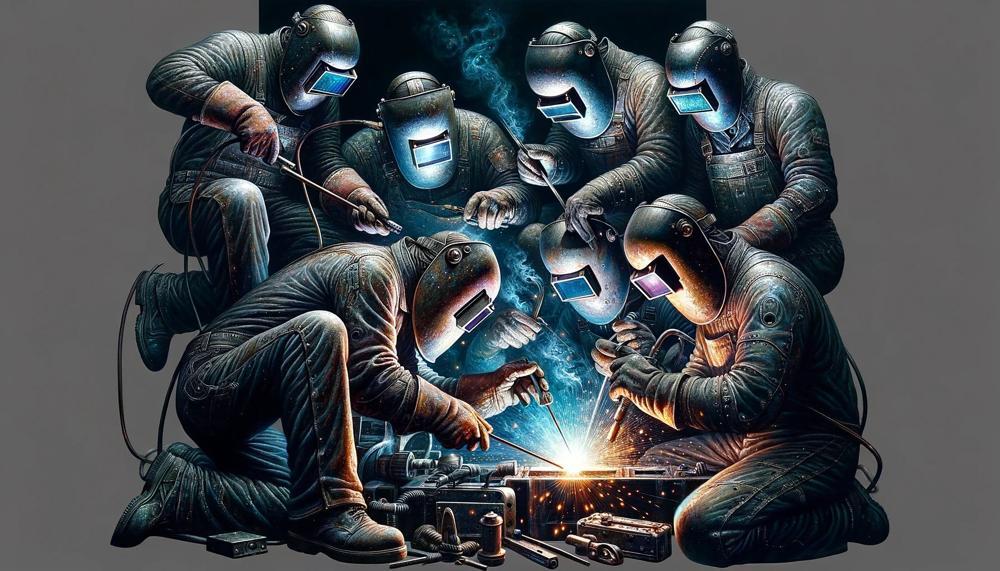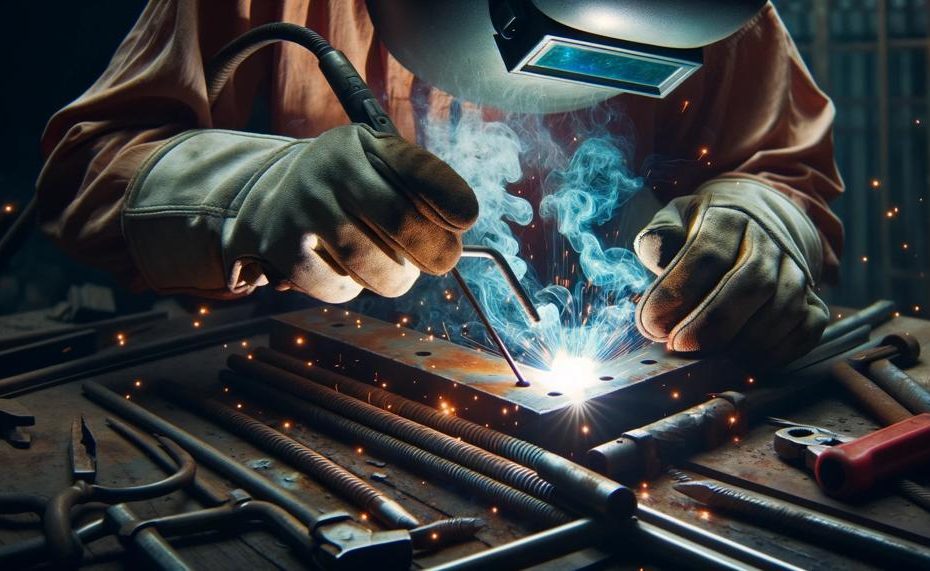Are you ready to spark some debate in the welding community? Whether you’re a novice or a pro, the question of which welding method is stronger – stick welding or MIG welding – has been a hot topic for decades. And it’s time to dive into this discussion and uncover the truth. So, is stick welding stronger than mig?
Stick welding is generally considered stronger than MIG welding for thicker materials. However, MIG welding can provide good welds for thinner metals.
Here are some other differences between MIG and stick welding:
- Weld quality: MIG welds are generally better aesthetically than stick welds.
- Indoor and outdoor applications: MIG welding can only be performed indoors because it uses a shielding gas. Stick welding can be performed outdoors or even underwater.
- Strength: Both E70s6 bare wire and 7018 stick wire used in MIG and stick welders are similarly strong. They have a tensile strength of 70,000 psi, which is higher than most steels.
- Foolproofness: Stick welding is more foolproof.
Contents
What is Stick Welding and How Does it Work?
Stick welding and MIG welding are two common methods of joining metal pieces together. These techniques employ an electric arc to melt the base metal and the filler material, creating a secure bond.
Although both processes have their own strengths and weaknesses, one significant difference between them is their strength capabilities.
The Basics of Stick Welding:
Also known as shielded metal arc welding (SMAW), stick welding is a manual process that uses a consumable electrode coated in flux to create an electric arc. This arc melts the base metal and the electrode, allowing them to fuse together.
The flux coating on the electrode serves as a shielding gas, preventing the molten weld pool from being contaminated by the surrounding air. Once the weld cools, the flux also acts as a layer of slag that protects the weld from oxidation and helps it solidify.
The Basics of MIG Welding:
MIG welding, or gas metal arc welding (GMAW), utilizes a continuous wire electrode and a shielding gas to protect the weld from contamination. The wire is fed through a wire feeder into the welding torch, where an electric current generates an arc between the wire and the base metal.
This heat melts both materials, creating a strong bond. The shielding gas, usually a mixture of argon and carbon dioxide, prevents atmospheric gases from weakening the weld.
Strength Comparison:
In terms of strength, stick welding usually produces more robust welds due to its ability to penetrate deeper into the base metal. This is because stick welding uses a flux coating that creates a layer of slag over the weld, allowing it to cool slowly and reducing the risk of cracking.
On the other hand, MIG welding does not use flux and relies solely on the shielding gas to protect the weld from contamination. This can result in faster cooling times and potentially weaker welds.
Factors Affecting Strength:
However, it is essential to note that the strength of a weld does not solely depend on the welding process used. Other factors such as the strength of the welding rod or filler wire, the quality of the joint, and the loading conditions also play a critical role in determining the weld’s strength.
Therefore, it is vital to carefully consider factors such as material type, available equipment, location, and productivity requirements when selecting the appropriate welding process.
Advantages of Stick Welding
Stick welding is a preferred technique for many welders due to its numerous advantages over MIG welding. These benefits include its versatility, cost-effectiveness, and ability to perform well in outdoor conditions.
- Versatility: One of the biggest advantages of stick welding is the flexibility it offers in creating different bead styles and patterns. This is possible because of its ability to adjust settings such as wire speed, voltage, and gas flow.
- Cost-effectiveness: Another key factor that makes stick welding a popular choice is its cost-effectiveness. Unlike MIG welding, it does not require external gas, making it a more budget-friendly option. Additionally, its operating costs are generally lower.
- Outdoor use: Stick welding is also a more suitable option for outdoor applications as it can still produce quality welds even in adverse weather conditions. This is due to its flux coating, which creates its own shield gas.
- Electrode choices: With stick welding, there are various electrode choices available for different projects and materials. This allows for greater versatility in welding different types of joints and metals.
- Beginner-friendly: For those new to welding, stick welding is often recommended as a first technique to learn. It is relatively simple to set up and master compared to MIG welding.
- Employer preference: Many employers prefer employees with stick welding skills as it demonstrates versatility and can lead to better job opportunities. This is especially true in industries such as construction and manufacturing.
Disadvantages of Stick Welding
Stick welding, while beneficial in many ways, also has its disadvantages when compared to MIG welding. These include:
- Limited Precision: Stick welding does not offer a wide range of control options, making it less precise when it comes to creating intricate welds or calculations. This can be a significant disadvantage for welders who need to work with small or detailed pieces.
- Slower Process: Stick welding is generally slower than MIG welding due to the constant need to change and replace electrodes. This can result in longer production times and increased labor costs.
- More Spatter and Fumes: Stick welding produces more spatter and fumes compared to MIG welding, which can be hazardous to the welder’s health and require additional safety measures.
- Lower Metal Penetration: While stick welding has a better metal penetration rate than MIG welding, it is still lower compared to other welding techniques. This can be a disadvantage when working with thicker metals or joints that require deep penetration.
- Steeper Learning Curve: Stick welding requires a higher level of skill and experience compared to MIG welding, making it less accessible for beginners or those with limited welding experience. It takes time and practice to master the nuances of this technique.
- Equipment Cost: The equipment needed for stick welding can be more expensive compared to MIG welding, especially if using higher-quality electrodes or working on larger projects.
To put it simply, while stick welding does have many advantages, it may not be the most suitable option for every project. It’s essential to weigh the potential drawbacks of this technique against those of MIG welding before deciding which one is best for a particular project.
What is MIG Welding and How Does it Work
When it comes to welding, two popular methods stand out: MIG welding and stick welding. Both techniques have distinct differences in terms of strength and process. Let’s examine these differences more closely.
- Electrode: MIG welding uses a consumable solid wire as its electrode, which is fed automatically from a spool. On the other hand, stick welding utilizes a coated electrode that burns to create the filler metal and its own shielding gas.
- Shielding Gas: In MIG welding, an inert gas such as argon is used to shield the weld from atmospheric contamination. In contrast, stick welding does not require external shielding gas as the coating on the electrode produces its own gas when burned.
- Strength: Generally, MIG welding results in a stronger and more consistent weld compared to stick welding. This is because MIG welding allows for better control over heat input and filler metal placement, resulting in a more precise and uniform weld. In contrast, stick welding can produce spatter and slag that may weaken the weld.
- Process: MIG welding is typically faster and more efficient than stick welding. The continuous wire feeding process allows for uninterrupted welding without frequent starts and stops, making it ideal for large projects. Stick welding, on the other hand, requires frequent electrode changes and may result in more downtime.
- Versatility: Stick welding can be performed in various environments, including outdoor or submerged conditions, due to its resistance to wind and liquids. In contrast, MIG welding must be done indoors as it relies on an inert gas that can be affected by external factors.
Advantages of MIG Welding
MIG welding, also known as Gas Metal Arc Welding (GMAW), has become a preferred method in many industries due to its numerous advantages over stick welding. It is more versatile, efficient, and easier to use, resulting in higher quality and smoother welds.
One of the main advantages of MIG welding is its versatility. Unlike stick welding, which is limited to certain types of metals, MIG welding can be used on a wide range of materials including aluminum, stainless steel, and mild steel. This makes it a popular choice for various projects and industries.
In addition to its versatility, MIG welding also offers higher efficiency compared to stick welding. This is because it uses a continuous wire feed, making it easier to maintain a consistent weld. Unlike stick welding, there is no need to constantly stop and change electrodes, resulting in a faster and more efficient process.
Moreover, MIG welding produces higher quality welds due to the use of inert gas for shielding. This prevents any contamination and results in cleaner and stronger welds. It also has a higher margin for error compared to stick welding, meaning slight variations in the weld will still provide a strong joint.
Another advantage of MIG welding is its ease of use. It is generally easier to learn and use compared to stick welding, making it a great option for beginners or those looking for a simpler welding process. This also results in smoother and more consistent welds compared to stick welding.
Overall, the benefits of using MIG welding over stick welding make it a popular choice in various industries. Its versatility, efficiency, higher quality welds, ease of use, and smoother finishes make it an ideal method for creating clean and strong joints on different types of metals.
Disadvantages of MIG Welding
When it comes to welding, MIG welding may not always be the best choice. Although it offers efficiency and versatility, there are several disadvantages that can make it less suitable for certain applications when compared to stick welding.
One of the main disadvantages of MIG welding is its lower metal penetration rate. In simpler terms, this means that the resulting weld may not be as strong or durable as one made with stick welding. This makes stick welding a better option for thicker materials or critical structural joints.
Additionally, MIG welding requires a high level of skill and experience to produce quality welds. This means that the welder needs to have a good understanding of the equipment, settings, and techniques to ensure proper weld penetration and fusion. In contrast, stick welding is relatively easier to learn and can be done by beginners.
Moreover, MIG welding equipment is more expensive than stick welding equipment. This includes the machine, wire, gas, and other accessories. This can be a significant disadvantage for those on a tight budget or just starting out in welding.
Last but not least, MIG welding produces more spatter and fumes compared to stick welding. This can be hazardous to the welder’s health if proper safety precautions are not taken. The use of protective gear such as gloves, mask, and ventilation systems is essential when performing MIG welding.

So, is Stick Welding Stronger than MIG?
| Key Differences Between Stick Welding and MIG Welding |
| Stick welding and MIG welding are two common welding techniques used in various industries. Both have their own advantages and disadvantages, but which one is better? Let’s dive into the key differences between these two techniques. |
| Electrode Type |
| Stick welding uses a consumable electrode that is covered in flux, while MIG welding uses a continuous spool of wire. The type of electrode used affects the overall performance of the weld, making stick welding more suitable for certain applications and MIG welding for others. |
| Heat Generation |
| In stick welding, the heat is lower due to the manual feeding of the electrode. On the other hand, MIG welding generates higher heat due to the continuous feeding of wire. This difference in heat generation can affect the quality and strength of the weld. |
| Penetration Rate |
| The design of the electrode used in stick welding allows for deeper penetration, making it more suitable for thicker materials. In contrast, MIG welding has a shallower penetration rate, making it better for thinner materials. |
| Deposition Rate |
| Stick welding has a higher deposition rate compared to MIG welding, resulting in stronger and more consistent welds. However, MIG welding requires more precision from the welder to achieve strong welds due to its lower deposition rate. |
| Skill Level Required |
| Stick welding requires a higher skill level and more precise welding technique, making it more suitable for experienced welders. In contrast, MIG welding is easier to learn and use, making it a more beginner-friendly option. |
| Equipment Cost |
| The equipment needed for basic stick welding set-up is less expensive compared to the equipment needed for MIG welding, which includes shielding gas and a wire spool. This makes stick welding a more budget-friendly option. |
| Potential Health Hazards |
| Both stick welding and MIG welding can produce fumes and sparks that can be hazardous to health if proper precautions are not taken. It is important for welders to wear protective gear and have proper ventilation in the work area. |
Conclusion
After much debate and discussion, the question of whether stick welding is stronger than MIG welding still remains unanswered. Both methods have their own set of advantages and disadvantages, making it difficult to declare a clear winner.
While stick welding is known for its versatility and portability, MIG welding boasts faster production rates.
However, when it comes to strength, stick welding has an edge over MIG welding in thicker materials. Its ability to penetrate deep into the base metal results in more robust welds. On the other hand, MIG welding excels in creating clean and aesthetically pleasing welds in thinner materials.
But let’s not forget that the choice between these two methods ultimately depends on various factors such as material type, joint design, and project requirements. It’s crucial to carefully consider these factors before deciding on the appropriate technique for your welding project.
Whether you’re a novice or an experienced welder, understanding the strengths and limitations of each method can help you make an informed decision and achieve high-quality welds with confidence.





